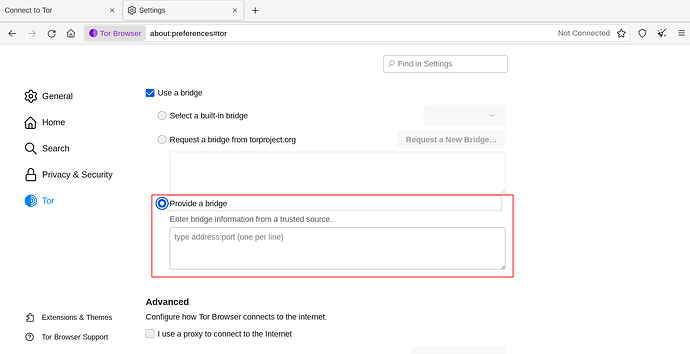I’ve run a relay out of my house and one in a data center. I ran a bridge in a data center. All OK.
But trying to bring the bridge into the house on a NUC is giving me the following error.
There is nothing in the log that is complaining.
The ports are reachable from the Internet.
When I start the relay, I see a few connections and then within 30 minutes, they drop. I’m used to seeing an update on how many clients were seen but I’m not seeing that.
I’m thinking of scratching the OS and start again. This error is very rare in Google.
Any pointers appreciated.
Bridge * advertises:
* obfs4: dysfunctional
Error: timed out waiting for bridge descriptor
Last tested: 2022-05-03 00:38:31.494408719 +0000 UTC (3h8m7.161881599s ago)
May 02 22:40:14.314 [notice] We compiled with OpenSSL 101010df: OpenSSL 1.1.1m 14 Dec 2021 and we are running with OpenSSL 101010df: 1.1.1m. These two versions should be binary compatible.
May 02 22:40:14.373 [notice] Tor 0.4.6.9 (git-ea2ada6d1459f829) running on Windows 8 [or later] with Libevent 2.1.12-stable, OpenSSL 1.1.1m, Zlib 1.2.11, Liblzma N/A, Libzstd N/A and Unknown N/A as libc.
May 02 22:40:14.375 [notice] Tor can't help you if you use it wrong! Learn how to be safe at https://www.torproject.org/download/download#warning
May 02 22:40:14.475 [notice] Read configuration file "*\tor\torrc".
May 02 22:40:14.481 [notice] Based on detected system memory, MaxMemInQueues is set to 2048 MB. You can override this by setting MaxMemInQueues by hand.
May 02 22:40:14.488 [notice] Opening OR listener on *:9001
May 02 22:40:14.488 [notice] Opened OR listener connection (ready) on *:9001
May 02 22:40:14.488 [notice] Opening Extended OR listener on 127.0.0.1:0
May 02 22:40:14.488 [notice] Extended OR listener listening on port 50638.
May 02 22:40:14.488 [notice] Opened Extended OR listener connection (ready) on 127.0.0.1:50638
May 02 22:41:34.000 [notice] Parsing GEOIP IPv4 file *\geoip.
May 02 22:41:35.000 [notice] Parsing GEOIP IPv6 file *\geoip6.
May 02 22:41:36.000 [notice] Configured to measure statistics. Look for the *-stats files that will first be written to the data directory in 24 hours from now.
May 02 22:41:37.000 [notice] Your Tor server's identity key fingerprint is '* *'
May 02 22:41:37.000 [notice] Your Tor bridge's hashed identity key fingerprint is '(* *'
May 02 22:41:37.000 [notice] Your Tor server's identity key ed25519 fingerprint is '* *'
May 02 22:41:37.000 [notice] You can check the status of your bridge relay at https://bridges.torproject.org/status?id=*
May 02 22:41:37.000 [notice] Bootstrapped 0% (starting): Starting
May 02 22:44:01.000 [notice] Starting with guard context "default"
May 02 22:44:01.000 [notice] Registered server transport 'obfs4' at '*:443'
May 02 22:44:02.000 [notice] Bootstrapped 5% (conn): Connecting to a relay
May 02 22:44:02.000 [notice] Bootstrapped 10% (conn_done): Connected to a relay
May 02 22:44:02.000 [notice] Bootstrapped 14% (handshake): Handshaking with a relay
May 02 22:44:03.000 [notice] Bootstrapped 15% (handshake_done): Handshake with a relay done
May 02 22:44:03.000 [notice] Bootstrapped 75% (enough_dirinfo): Loaded enough directory info to build circuits
May 02 22:44:03.000 [notice] Bootstrapped 90% (ap_handshake_done): Handshake finished with a relay to build circuits
May 02 22:44:03.000 [notice] Bootstrapped 95% (circuit_create): Establishing a Tor circuit
May 02 22:44:04.000 [notice] Bootstrapped 100% (done): Done
May 02 22:44:04.000 [notice] Now checking whether IPv4 ORPort *:9001 is reachable... (this may take up to 20 minutes -- look for log messages indicating success)
May 02 22:44:05.000 [notice] Self-testing indicates your ORPort *:9001 is reachable from the outside. Excellent. Publishing server descriptor.
May 02 22:44:10.000 [notice] Performing bandwidth self-test...done.
- = Real values obscured
